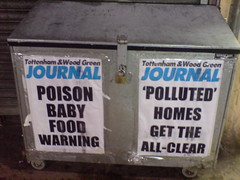Question by : What's the difference between stomach flu and food poisoning?
last night the only thing I could think of that made me sick was a tall glass of eggnog that was a few days before its expiration date.
Well I had severe cramps and whenever I stood up I got really dizzy(urge to faint) and so I laid down on the floor after having diarhea. I don't feel dizzy anymore and I don't have diarhea. I only threw up once.
So is it the stomach flu or food poisoning? No chills.
Best answer:
could be either, stomach flu is obviously caused by a virus, and food poisoning is caused by bacteria. Without further symptoms, like fever, I'd bet it's a virus and just has to run it's course. It would benefit you to get some probiotics to replace the good bacteria your intestines use for digestion.
Florastor - 50 count, 250mg
stomach flu or food poisoning - click on the image below for more information.

- Helps maintain normal balance of the intestinal flora and promotes intestinal health
- Protect your intestinal tract and keeps your intestines functioning well
- A probiotic made of live freeze dried yeast cells of the species Saccharomyces boulardii
stomach flu or food poisoning
Florastor helps maintain the balance in your intestines and is safe to take with other medicines. Florastor is a probiotic made of live freeze dried yeast cells of the species Saccharomyces boulardii. The cells are put into capsules and sealed. Each capsule of Florastor has 250 mg of S. boulardii in it. Probiotics help the good organisms in your body to grow and protect your intestines against "bad" organisms that can make you unwell.
Florastor - 50 count, 250mg
Click on the button for more stomach flu or food poisoning information and reviews.
Know About Food Poisoning
Food poisoning usually begins suddenly with a feeling of nausea and abdominal cramps, followed by vomiting, diarrhea, and weakness. Rectal burning may be intense, and the stools may contain blood and mucus. All of this loss of fluid from the bowel may result in severe dehydration and shock. There is pain in the abdomen, with some distension, especially in the lower area.
Food-borne illness or commonly referred to as food poisoning is frequently not recognized because of it's resemblance to the stomach flu. Both food poisoning and the stomach flu share these symptoms: headache, vomiting, diarrhea, abdominal cramps and fever. Food poisoning symptoms don't necessarily show up immediately after eating the contaminated food; they can show up as late as 36 hours later. The one symptom that is unique to food poisoning and not the flu is bloody diarrhea- go to the doctor's immediately with this symptom. Left untreated some types of food poisoning can be fatal, so seek immediate medical attention particularly if the symptoms are present in a child.
Food poisoning from chemicals is rare and usually results from accidental ingestion when poisonous chemicals are stored in unlabelled bottles or food is contaminated with chemicals or additives. Metallic poisoning causes vomiting and abdominal pains and results from the contamination of food and drink by contact with metals.
]]>
Spicy and oily foods, per se, do not cause food poisoning. Improperly prepared and incorrectly stored foods of all kinds are the culprits. Depending on the type of bacteria or toxin, and in rare cases yeasts, your bodies response can be as soon as 1 hour and up to 4 days. I do not know what else you prepared other than the chicken, but your scenario implies that there was cross-contamination from the raw chicken to an uncooked vegetable or fruit. Never use the same cutting board for meats and vegetables. Sanitize any meat prep area by wiping up meat juices with a paper towel, then wash and rinse the area, then sanitize w/ bleach water (about 1 teaspoon chlorine bleach to 1 quart of water - more than that is overkill).
When food is cooked and left out for more than 2 hours at room temperature, bacteria can multiply quickly. Most bacteria grow undetected because they do not produce an "off" odor or change the color or texture of the food. Freezing food slows or stops bacteria's growth but does not destroy the bacteria. The microbes can become reactivated when the food is thawed. Refrigeration may slow the growth of some bacteria, but thorough cooking is needed to destroy the bacteria.
When packing the foods prepared to take along you should put the food items in an air tight container. The food can be put in a cooler to keep it cool. Make sure you put plenty of ice in the cooler to keep the food cool enough. When packing food in the cooler always pack the food you are going to use last first. When packing the cooler put the food in first and proceed to put the ice on top around the food complete covering it. Remember a full cooler keeps cooler longer. Keep plenty of ice around so you're able to keep refilling the cooler with ice as you need it. Pack pop in a separate cooler with ice.
Orignal From: What's the difference between stomach flu and food poisoning?


No comments:
Post a Comment